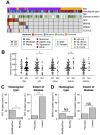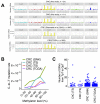Genomic landscape of colitis-associated cancer indicates the impact of chronic inflammation and its stratification by mutations in the Wnt signaling
- PMID: 29416670
- PMCID: PMC5787528
- DOI: 10.18632/oncotarget.22867
Genomic landscape of colitis-associated cancer indicates the impact of chronic inflammation and its stratification by mutations in the Wnt signaling
Abstract
Inflammatory bowel disease (IBD) increases the risk of colorectal cancer, known as colitis-associated cancer (CAC). It is still unclear what driver mutations are caused by chronic inflammation and lead to CAC development. To get insight into this issue, we investigated somatic alterations in CAC. We performed exome sequencing of 22 fresh CACs and targeted sequencing of 43 genes on 90 archive specimens from Japanese CAC patients, of which 58 were ulcerative colitis (UC) and 32 were Crohn's disease (CD). Consistently with the previous reports, TP53 was commonly mutated (66%) whereas APC, KRAS and SMAD4 were mutated less frequently (16%, 11% and 11%, respectively). Mucinous CD-CACs in the anus, an Asian-specific subtype of CD-CAC, had less somatic mutations in our target genes. We also found that RNF43, a negative regulator of the Wnt signaling, was somatically mutated in a significant fraction of CACs (10 of 90; 11%). Two lines of evidence indicated that somatic mutations of RNF43 were related to chronic inflammation. First, somatic mutations of RNF43 were significantly associated with longer duration of IBD. Second, clinico-pathological features suggested many of the APC-mutated CACs were actually sporadic colorectal cancer whereas RNF43-mutated CACs did not have this tendency. RNA-Seq analysis showed that RNF43-mutated CACs had elevated expression of c-Myc and its target genes, suggesting that RNF43 is a bona fide driver of CAC development. This study provides evidence that somatic mutation of RNF43 is the driver genetic alteration that links chronic inflammation and cancer development in about 10% of CACs.
Keywords: APC; RNF43; colitis-associated cancer; inflammatory bowel disease; next-generation sequencing.
Conflict of interest statement
CONFLICTS OF INTEREST The authors declare no conflicts of interest associated with this manuscript.
Figures





Similar articles
-
Genomic Alterations Observed in Colitis-Associated Cancers Are Distinct From Those Found in Sporadic Colorectal Cancers and Vary by Type of Inflammatory Bowel Disease.Gastroenterology. 2016 Aug;151(2):278-287.e6. doi: 10.1053/j.gastro.2016.04.001. Epub 2016 Apr 8. Gastroenterology. 2016. PMID: 27063727 Free PMC article.
-
Whole-Exome Sequencing Analyses of Inflammatory Bowel Disease-Associated Colorectal Cancers.Gastroenterology. 2016 Apr;150(4):931-43. doi: 10.1053/j.gastro.2015.12.036. Epub 2016 Jan 5. Gastroenterology. 2016. PMID: 26764183 Free PMC article.
-
Chronic ulcerative colitis and colorectal cancer.Cancer Lett. 2014 Apr 10;345(2):235-41. doi: 10.1016/j.canlet.2013.07.032. Epub 2013 Aug 11. Cancer Lett. 2014. PMID: 23941831 Review.
-
Whole Exome Sequencing of Ulcerative Colitis-associated Colorectal Cancer Based on Novel Somatic Mutations Identified in Chinese Patients.Inflamm Bowel Dis. 2019 Jul 17;25(8):1293-1301. doi: 10.1093/ibd/izz020. Inflamm Bowel Dis. 2019. PMID: 30794281
-
Genomic characterization of colitis-associated colorectal cancer.World J Surg Oncol. 2018 Jul 2;16(1):121. doi: 10.1186/s12957-018-1428-0. World J Surg Oncol. 2018. PMID: 29966533 Free PMC article. Review.
Cited by
-
Genomic aberrations after short-term exposure to colibactin-producing E. coli transform primary colon epithelial cells.Nat Commun. 2021 Feb 12;12(1):1003. doi: 10.1038/s41467-021-21162-y. Nat Commun. 2021. PMID: 33579932 Free PMC article.
-
ADAM10 and ADAM17 as Biomarkers Linked to Inflammation, Metabolic Disorders and Colorectal Cancer.Curr Issues Mol Biol. 2022 Sep 29;44(10):4517-4527. doi: 10.3390/cimb44100309. Curr Issues Mol Biol. 2022. PMID: 36286024 Free PMC article.
-
Machine learning‑based radiomics models accurately predict Crohn's disease‑related anorectal cancer.Oncol Lett. 2024 Jul 3;28(3):421. doi: 10.3892/ol.2024.14553. eCollection 2024 Sep. Oncol Lett. 2024. PMID: 39035049 Free PMC article.
-
Somatic inflammatory gene mutations in human ulcerative colitis epithelium.Nature. 2020 Jan;577(7789):254-259. doi: 10.1038/s41586-019-1844-5. Epub 2019 Dec 18. Nature. 2020. PMID: 31853059
-
The Wnt signaling pathway in tumorigenesis, pharmacological targets, and drug development for cancer therapy.Biomark Res. 2021 Sep 6;9(1):68. doi: 10.1186/s40364-021-00323-7. Biomark Res. 2021. PMID: 34488905 Free PMC article. Review.
References
-
- Berasain C, Castillo J, Perugorria MJ, Latasa MU, Prieto J, Avila MA. Inflammation and liver cancer: new molecular links. Ann N Y Acad Sci. 2009;1155:206–21. - PubMed
-
- Ekbom A, Helmick C, Zack M, Adami HO. Ulcerative colitis and colorectal cancer. A population-based study. N Engl J Med. 1990;323:1228–33. - PubMed
LinkOut - more resources
Full Text Sources
Other Literature Sources
Research Materials
Miscellaneous

